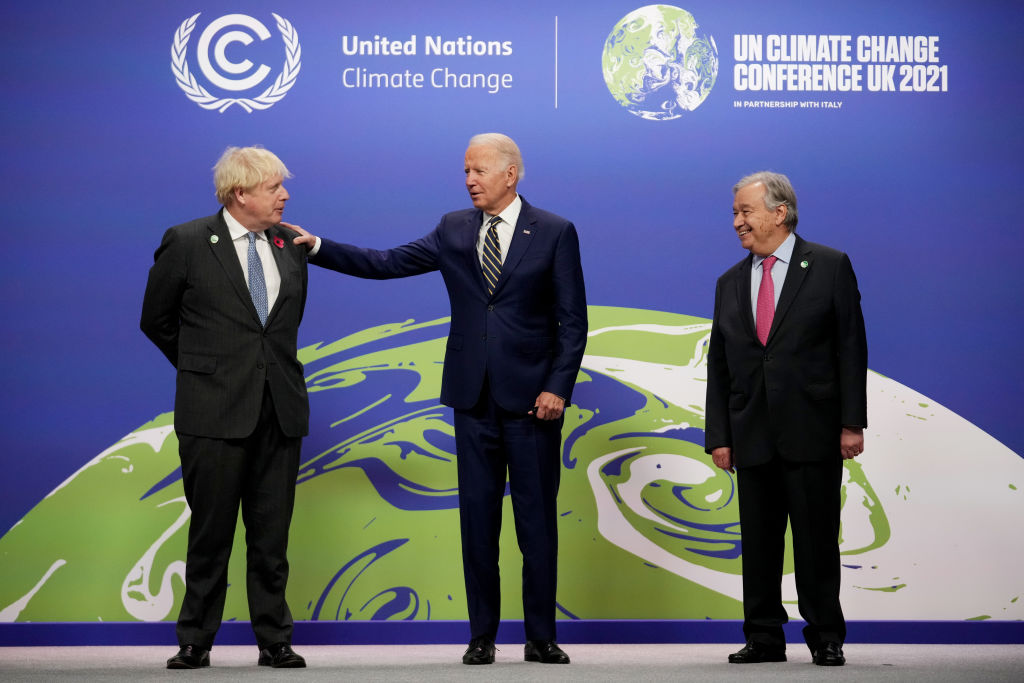In the early 2010s, climate scientists were painting a grim picture of the future: If humans didn’t curb carbon dioxide emissions, the world was headed toward 4 degrees Celsius (7.2 degrees Fahrenheit) of warming by the end of the century.
A decade later, the planet is on a different path. Scientists now estimate that current emissions trajectories make a 4-degree scenario highly implausible, even as total carbon emissions continue to rise. In fact, a new study estimates that if countries fulfill the climate pledges they made at the United Nations climate change conference known as COP26 last year, warming could be limited to just below 2 degrees C (3.6 degrees Fahrenheit) by 2100.
That’s a more optimistic outlook than those found in the assessments released in the months leading up to COP26. Based on the pledges that countries had made prior to the conference, those studies found that there was a less than 50 percent chance of keeping warming to below 2 degrees C, the goal set by the world’s countries in the 2016 Paris Agreement. Indeed, the commitments prior to COP26 put the world on track for a global temperature rise of 2.7 degrees.
“Our results provide a reason to be optimistic,” the researchers noted in the new study, which was published in the scientific journal Nature this week. “Warming could be limited to 2 C or just below, if the pledges on the table are implemented in full and on time.”
It’s a big “if.” The study assessed 154 pledges submitted by countries at the end of COP26. All 154 commitments included targets to cut emissions by 2030, and 76 included long-term targets stretching out to 2050 and beyond. In modeling temperature increases, the researchers assumed full implementation of countries’ pledges and took into account both short-term and long-term commitments. For countries that only pledged short-term reductions through 2030, the researchers extrapolated a similar trajectory to the end of the century. (The study also noted that a handful of countries — including Pakistan, Turkey, and Vietnam — had set unusually high emissions targets that would be reachable without any new policy initiatives and do little to reduce warming.)
There are already some indications that countries are not on target to meet their pledges. Last year, a United Nations report found that G20 countries, the world’s 20 largest economies, are likely to collectively fall short of their initial climate pledges by 1.1 gigatons of carbon dioxide equivalent per year — roughly 3 percent of their total annual emissions. Of the nine G20 countries that the report examined in detail, all had promised to eventually reach net-zero emissions, but none of them had reduction benchmarks that would actually put them on the path to net-zero.
In an analysis accompanying the new Nature study, climate scientists Zeke Hausfather and Frances Moore said that long-term targets should be “treated with skepticism” if they’re not backed by strong short-term commitments that drastically cut emissions as soon as possible. “It is easy to set ambitious climate targets for 30, 40 or even 50 years in the future — but it is much harder to enact policies today that shift energy systems towards a more sustainable future,” they wrote.
The new study also adds to the growing consensus that limiting warming to 1.5 degrees C — the target that became a global rallying cry following the advocacy of vulnerable island nations during the 2015 U.N. climate negotiations — is basically out of reach, even under the most ambitious policy scenario modeled by the researchers.
The difference between 1.5 and 2 degrees of warming is the difference between life and death for many of the world’s most vulnerable people — and the difference between survival and extinction for some entire countries subject to sea level rise. The prime minister of Barbados, for instance, called 2 degrees of warming a “death sentence.”
While the 1.5-degree target is increasingly unlikely, it’s not yet entirely impossible, according to the researchers.
“Strong action will leave us with peak warming around 1.5 °C, whereas weak action will see temperature continue to rise to 1.7, 1.8, 2.0 °C or higher,” they noted. “Any delay in reversing the upward trend of emissions, phasing out the unabated use of fossil fuels and developing sustainable, additional and permanent negative-emissions options will put this target out of reach.”




